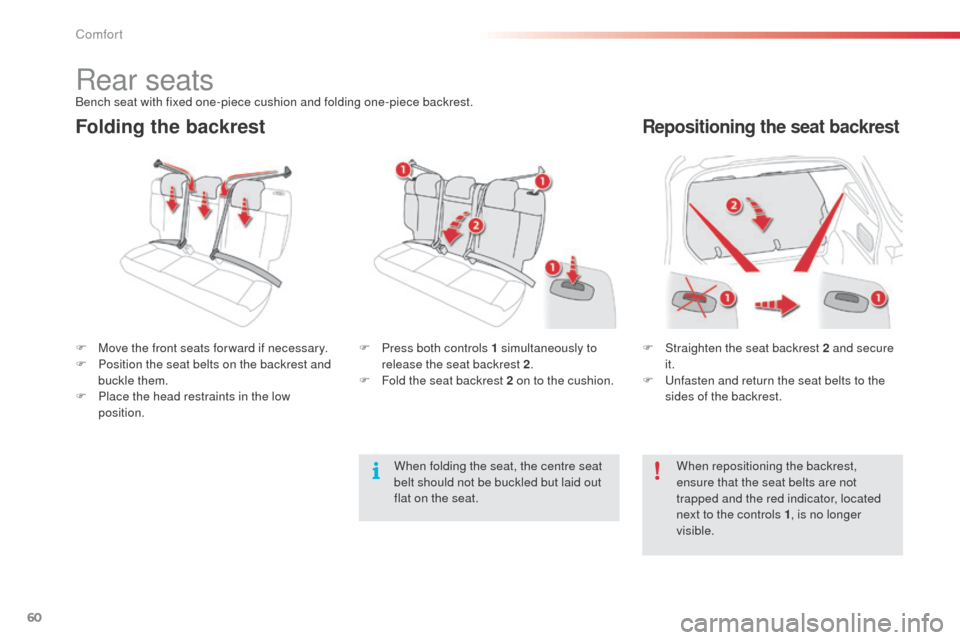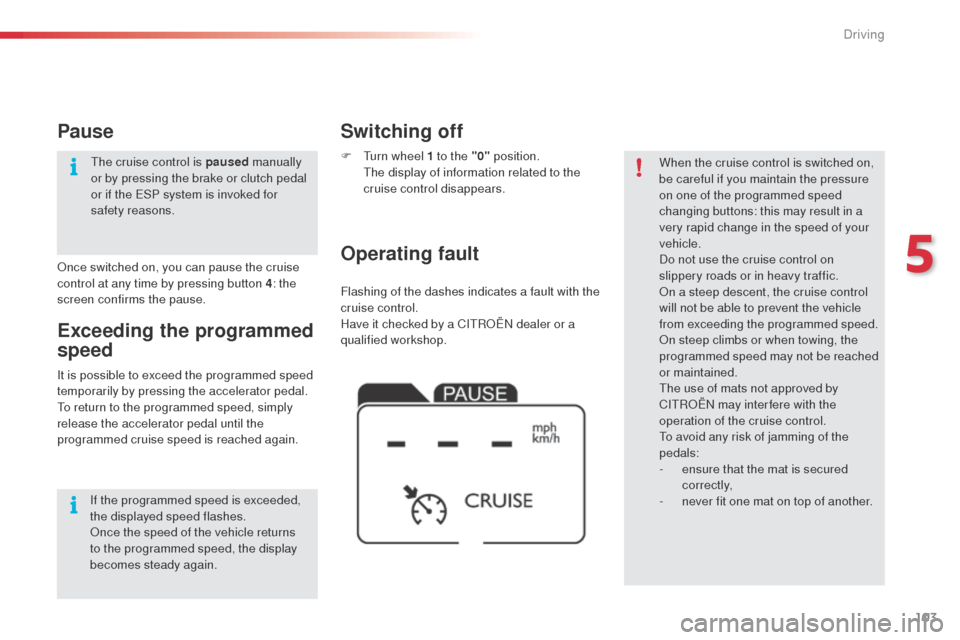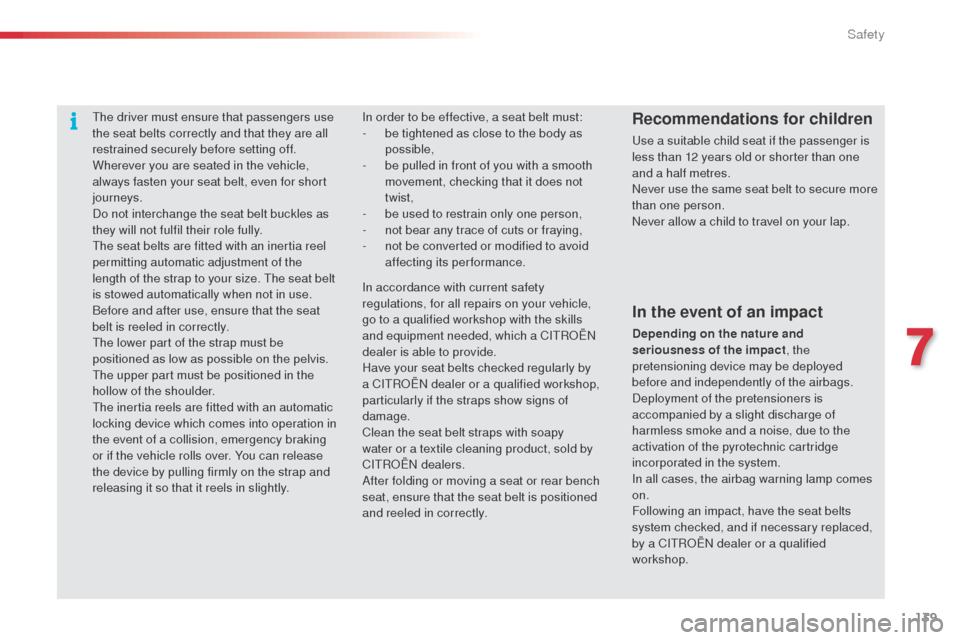ECU Citroen C4 CACTUS RHD 2014 1.G Owner's Manual
[x] Cancel search | Manufacturer: CITROEN, Model Year: 2014, Model line: C4 CACTUS RHD, Model: Citroen C4 CACTUS RHD 2014 1.GPages: 331, PDF Size: 8.56 MB
Page 54 of 331

52
Manual central locking
Central locking
F Press this button to operate the central locking
of the vehicle (doors and boot) from inside the
vehicle, the indicator lamp in the button comes on.
F Pressing the button again unlocks the vehicle completely, the indicator lamp in the button
goes off.
Automatic central
locking
(anti-intrusion security)
The doors and boot can lock automatically
while driving (speed above 6 mph (10 km/h)).
To activate or deactivate this function
(activated by default):
F
P
ress this button until an audible signal
is heard and a message appears in the
screen.
If one of the doors is open, central
locking from the inside does not take
place. Driving with the doors locked may make
access to the passenger compartment
by the emergency services more
difficult in an emergency.Transporting long or voluminous
objects
If you want to drive with the boot open,
press the central locking control button
to lock the doors.
If the vehicle is deadlocked or locked
from the outside, the button is not
active. If the vehicle is not deadlocked,
use the remote control to unlock the
vehicle or pull an interior door handle to
open a door.
Access
Page 59 of 331

57
Rear door windows
OpeningClosing
F Tilt the lever outwards.
F
P ush it fully to secure the window in the
open position. F
P
ull the lever to release the window.
F
T
ilt the lever fully inwards to secure the
window in the closed position.
Each window can be hinged open to provide ventilation at the rear seats.
2
Access
Page 62 of 331

60
Folding the backrestRepositioning the seat backrest
F Straighten the seat backrest 2 and secure it.
F
U
nfasten and return the seat belts to the
sides of the backrest.
F
M
ove the front seats for ward if necessary.
F
P
osition the seat belts on the backrest and
buckle them.
F
P
lace the head restraints in the low
position. F
P
ress both controls 1 simultaneously to
release the seat backrest 2 .
F
F
old the seat backrest 2 on to the cushion.
When repositioning the backrest,
ensure that the seat belts are not
trapped and the red indicator, located
next to the controls 1, is no longer
visible.
Rear seatsBench seat with fixed one-piece cushion and folding one-piece backrest.
When folding the seat, the centre seat
belt should not be buckled but laid out
flat on the seat.
Comfort
Page 84 of 331

82
To remove the mat on the driver's side:
F m ove the seat as far back as possible,
F
un
clip the fixings,
F
r
emove the mat.
Mats
Removable carpet protection.
Fitting
When fitting the mat for the first time, on the
driver's side use only the fixings provided.
The other mats are simply placed on the
carpet.
RemovalTo avoid any risk of jamming of the
pedals:
-
o
nly use mats which are suited to
the fixings already present in the
vehicle; these fixings must be used,
-
n
ever fit one mat on top of another.
The use of mats not approved by
CITROËN may inter fere with access to
the pedals and hinder the operation of
the cruise control / speed limiter.
The mats approved by CITROËN have
two fixings located below the seat.
Refitting
To refit the mat on the driver's side:
F p osition the mat correctly,
F
r
efit the fixings by pressing,
F
c
heck that the mat is secured correctly.
Fittings
Page 85 of 331

83
Boot fittings
1. Rear parcel shelf.
2. Hook.
3.
S
torage box.
4.
S
torage net (accessory).
5.
S
torage net fixing rings.
The storage net fixing rings are not
intended to secure loads or restrain
baggage.
4
Fittings
Page 86 of 331

84
To remove the shelf:
F u nhook the two cords,
F
r
aise the shelf slightly, then remove it.
Rear parcel shelf
There are several options for storing the shelf:
- ei ther upright behind the front seats,
-
o
r flat at the base of the boot. It can be used to secure shopping bags.
Hook
Storage box
For versions with storage box: it must
be in place before loading the boot.
F
R
emove the boot carpet for access to the
storage box.
Depending on the configuration, it is laid out for
storing:
-
a t
owing eye,
-
a t
emporary puncture repair kit,
-
a w
arning triangle,
-
...
Fittings
Page 102 of 331

100
On sharp acceleration, as when
descending a steep hill, the speed
limiter will not be able to prevent
the vehicle from exceeding the
programmed speed.
The limiter is temporarily deactivated
and the displayed programmed speed
flashes.
An audible signal accompanies the
flashing of the programmed speed
when exceeding the speed is not due to
an action by the driver.
The use of mats not approved by
CITROËN may inter fere with the
operation of the speed limiter.
To avoid any risk of jamming of the
pedals:
-
e
nsure that the mat is secured
c o r r e c t l y,
-
d
o not fit one mat on top of another.
Flashing of the dashes indicates a fault with the
speed limiter.
Have it checked by a CITROËN dealer or a
qualified workshop.
Operating fault
Switching off
F Turn wheel 1 to the "0" position. T
he display of information related to the
speed limiter disappears.
F
Press
firmly on the accelerator pedal,
going beyond the point of resistance,
to
exceed the programmed speed limit.
The speed limiter is deactivated temporarily
and the displayed programmed speed flashes.
Temporarily exceeding the
programmed speed
As soon as the vehicle's speed returns to the
programmed value, the limiter operates again:
the display of the programmed speed becomes
steady again. An audible signal accompanies the
flashing of the programmed speed
when exceeding the speed is not due to
an action by the driver (steep hill...).
Driving
Page 105 of 331

103
Flashing of the dashes indicates a fault with the
cruise control.
Have it checked by a CITROËN dealer or a
qualified workshop.
Operating fault Switching off
F Turn wheel 1 to the "0" position. T
he display of information related to the
cruise control disappears. When the cruise control is switched on,
be careful if you maintain the pressure
on one of the programmed speed
changing buttons: this may result in a
very rapid change in the speed of your
vehicle.
Do not use the cruise control on
slippery roads or in heavy traffic.
On a steep descent, the cruise control
will not be able to prevent the vehicle
from exceeding the programmed speed.
On steep climbs or when towing, the
programmed speed may not be reached
or maintained.
The use of mats not approved by
CITROËN may inter fere with the
operation of the cruise control.
To avoid any risk of jamming of the
pedals:
-
e
nsure that the mat is secured
c o r r e c t l y,
-
n
ever fit one mat on top of another.
It is possible to exceed the programmed speed
temporarily by pressing the accelerator pedal.
To return to the programmed speed, simply
release the accelerator pedal until the
programmed cruise speed is reached again.
Exceeding the programmed
speed
Once switched on, you can pause the cruise
control at any time by pressing button 4: the
screen confirms the pause.
Pause
If the programmed speed is exceeded,
the displayed speed flashes.
Once the speed of the vehicle returns
to the programmed speed, the display
becomes steady again. The cruise control is paused
manually
or by pressing the brake or clutch pedal
or if the ESP system is invoked for
safety reasons.
5
Driving
Page 141 of 331

139
The driver must ensure that passengers use
the seat belts correctly and that they are all
restrained securely before setting off.
Wherever you are seated in the vehicle,
always fasten your seat belt, even for short
journeys.
Do not interchange the seat belt buckles as
they will not fulfil their role fully.
The seat belts are fitted with an inertia reel
permitting automatic adjustment of the
length of the strap to your size. The seat belt
is stowed automatically when not in use.
Before and after use, ensure that the seat
belt is reeled in correctly.
The lower part of the strap must be
positioned as low as possible on the pelvis.
The upper part must be positioned in the
hollow of the shoulder.
The inertia reels are fitted with an automatic
locking device which comes into operation in
the event of a collision, emergency braking
or if the vehicle rolls over. You can release
the device by pulling firmly on the strap and
releasing it so that it reels in slightly.Recommendations for children
Use a suitable child seat if the passenger is
less than 12 years old or shorter than one
and a half metres.
Never use the same seat belt to secure more
than one person.
Never allow a child to travel on your lap.
In order to be effective, a seat belt must:
-
b
e tightened as close to the body as
possible,
-
b
e pulled in front of you with a smooth
movement, checking that it does not
twist,
-
b
e used to restrain only one person,
-
n
ot bear any trace of cuts or fraying,
-
n
ot be converted or modified to avoid
affecting its performance.
In the event of an impact
Depending on the nature and
seriousness of the impact , the
pretensioning device may be deployed
before and independently of the airbags.
Deployment of the pretensioners is
accompanied by a slight discharge of
harmless smoke and a noise, due to the
activation of the pyrotechnic cartridge
incorporated in the system.
In all cases, the airbag warning lamp comes
on.
Following an impact, have the seat belts
system checked, and if necessary replaced,
by a CITROËN dealer or a qualified
workshop.
In accordance with current safety
regulations, for all repairs on your vehicle,
go to a qualified workshop with the skills
and equipment needed, which a CITROËN
dealer is able to provide.
Have your seat belts checked regularly by
a CITROËN dealer or a qualified workshop,
particularly if the straps show signs of
damage.
Clean the seat belt straps with soapy
water or a textile cleaning product, sold by
CITROËN dealers.
After folding or moving a seat or rear bench
seat, ensure that the seat belt is positioned
and reeled in correctly.
7
Safety
Page 147 of 331

145
Sit in a normal upright position.
Wear a correctly adjusted seat belt.
Do not leave anything between the
occupants and the airbags (a child, pet,
object...). This could hamper the operation of
the airbags or injure the occupants.
After an accident or if the vehicle has been
stolen or broken into, have the airbag
systems checked.
All work on the airbag system must be
carried out by a CITROËN dealer or a
qualified workshop.
Even if all of the precautions mentioned
are observed, a risk of injury or of minor
burns to the head, chest or arms when an
airbag is deployed cannot be ruled out.
The bag inflates almost instantly (within
a few milliseconds) then deflates within
the same time discharging the hot gas via
openings provided for this purpose.Front airbags
Do not drive holding the steering wheel by its
spokes or resting your hands on the centre
part of the wheel.
Passengers must not place their feet on the
dashboard.
Do not smoke as deployment of the airbags
can cause burns or the risk of injury from a
cigarette or pipe.
Never remove or pierce the steering wheel or
hit it violently.
Do not fit or attach anything to the steering
wheel or dashboard, this could cause
injuries with deployment of the airbags.
For the airbags to be fully effective, observe the following safety rules:
Lateral airbags
Use only approved covers on the seats,
compatible with the deployment the lateral
airbags. For information on the range of seat
covers suitable for your vehicle, you can
contact a CITROËN
dealer.
Refer to the "Accessories" section.
Do not fix or attach anything to the seat
backs (clothing...). This could cause injury
to the chest or arms if the lateral airbag is
deployed.
Do not sit with the upper part of the body any
nearer to the door than necessary.
Curtain airbags
Do not fix or attach anything to the roof. This
could cause injury to the head if the curtain
airbag is deployed.
If fitted on your vehicle, do not remove the
grab handles installed on the roof, they play
a part in securing the curtain airbags.
7
Safety